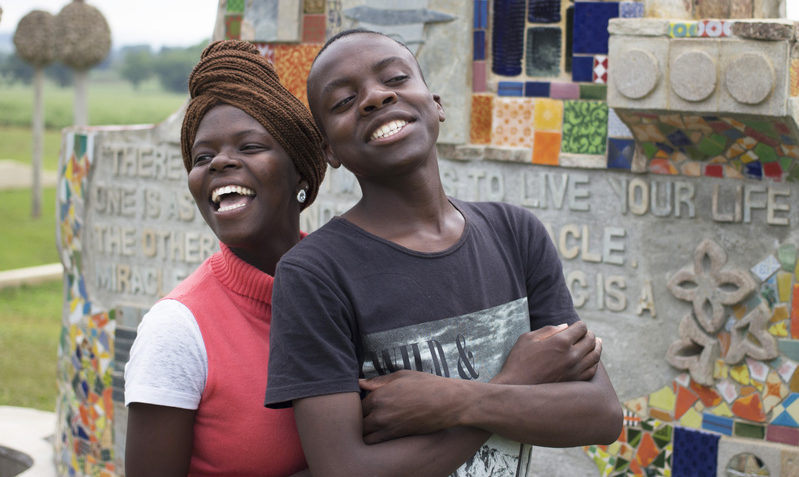Why is treatment adherence difficult for young people?
 @ Frontline AIDS
@ Frontline AIDS
With effective HIV treatment available, why are we seeing so many young people failing to adhere to treatment?
“When I found out I was HIV positive, I felt lonely and angry,” said Ntsiki, 22, from Swaziland. “I just needed someone to help me, to give me advice and counselling, to explain to me how I am going to take my treatment; at the right time, the right way, consistently.”
Ntsiki is now a Community Adolescent Treatment Supporter (CATS) providing peer-to-peer information, counselling and support to adolescents and young people living with HIV. I met her during a recent visit to Swaziland while producing a film about the CATS model.
In 2017, 65% of young people (aged 15-24) living with HIV across the world achieved viral suppression, which is when the level of HIV in the body is suppressed to such an extent you can live a healthy life and, if maintained, will not transmit the virus on to others. Whilst this is a significant improvement from two years ago, when viral suppression among this age group was 26%, it still means many young people with HIV fall ill and die.
With effective HIV treatment now available, why are we seeing so many young people failing to adhere to treatment?
First of all, many adolescents who were born with HIV don’t know they have it. Often, to protect them from stigma, their parents or caregivers will give them antiretrovirals (ARVs) but tell them it’s medication for something else.
At some point, however, these young people must learn about their HIV status. It is recommended that disclosure is complete by the age of 12, but many adolescents are much older when they find out they are living with HIV.
Adherence is tricky when the reason for, and the nature of, the medication is obscured. Due to this lack of knowledge, some young people only take their ARVs when they feel unwell, unaware of the importance of taking it every day.
Telling a child in your care they are HIV positive is not easy, particularly given the stigma that still surrounds HIV in most parts of the world (and certainly no less so in high prevalence areas like Swaziland). Parents and caregivers need support to navigate this topic, and information and skills to provide adequate support to their children.
Overcoming stigma
Children who grow up living with HIV often lack adequate care and support from their families. They internalise HIV stigma and feel unworthy and unlovable. Many are orphans, and it’s not uncommon for them to be stigmatised by their families and communities and bullied at school.
Adolescents are still in the process of developing their identity and sense of self and are therefore more vulnerable to negative attitudes and less able to cope with the impact.
Ntsiki found out she was HIV positive when she was 20. She had been ill and went to see a doctor, who asked her take an HIV test. Finding out the result, Ntsiki locked herself in her room for several days, feeling that all her hope was lost. Her mother initially made her keep her food in a separate fridge. However, she later revealed to Ntsiki that she was HIV positive herself, and their relationship has improved.
During my visit to Swaziland, I met Felisitas Ngubo, Regional Capacity Building Lead at Zvandiri/Africaid in Zimbabwe, who has been training CATS for 12 years. She told me: “Many young people, when they find out they are HIV positive, get very angry. They ask ‘why me’? They need support to process their feelings and get to a place of acceptance of their HIV status.
Many of them have never been loved or told they are beautiful.
Their HIV status comes to define them and limit what they think they can hope and expect for themselves. Many feel isolated, depressed and with no hope. If you feel you have no future, will never have a relationship, never be able to have children, never be able to do all those things you dreamed of, you’re less likely to prioritise your health and take a daily medication that, whilst keeping you healthy if taken correctly, promises no cure.
Felisitas’ words and Ntsiki’s experience show why psychosocial support for adolescents and young people living with HIV is so important.
CATS are trained in counselling and dealing with issues around treatment adherence; issues they understand because they themselves are likely to have experienced them too. They visit their clients at home and at the clinic, following them over time. They monitor their medication and their viral load, and link them to other services, such as child protection or sexual and reproductive health.
CATS can also help negotiate difficult family relations. Sipho, another CATS in Swaziland, told me how one of his clients lived with his grandmother, who wouldn’t let him eat off the same plate as the rest of the family. Sipho talked to the grandmother, explained how HIV does and doesn’t transmit, and was able to improve the situation for this young man.
The CATS model originated through the work of Africaid/Zvandiri in Zimbabwe, and is being rolled out in Swaziland, Mozambique and Tanzania through the READY+ programme.
It recognises and builds on what we know at the Alliance: that when young people themselves lead, design and deliver HIV programmes, they respond to what young people need.
This article was written as the International HIV/AIDS Alliance, before we changed our name to Frontline AIDS.
Tags
Community Adolescent Treatment Supporters (CATS)SwazilandYoung people


